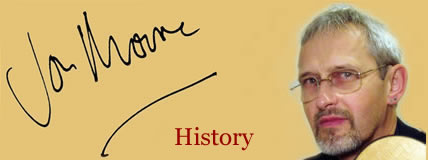
. welcome . hotcha . gig list .
. history . favourite guitars . tips and techniques .
. subscribe . guest book . contact .
“History is bunk.” Henry Ford
The band JUMPLEADS is probably the place to start. The time is the early 1980’s. Very odd that a self taught guitarist who’d spent his teenage and early twenty’s playing rock’n roll, doing Bob Dylan impressions, bashing out pop songs, and occasionally writing some of his own, should be in a band playing traditional music from the British Isles. It is even crazier that the link is jazz.
Having attended a workshop with the great American jazz guitarist, BARNEY KESSEL, which completely changed his approach to guitar playing, Jon set off the improve his musical ear. He did this by attending folk sessions in a local pub, where musicians spent the evening playing mostly traditional tunes. His aim was to pick up the tunes by ear, but those around him noticed he could readily hear and play an accompaniment almost before they’d played the tune through once. Before you could say “Winster Gallop” he was playing every weekend in barn dance (Ceilidh) bands.
Various loose affiliations finally gelled as JUMPLEADS. Caroline Ritson (now Caroline Butler with THE OXFORD WAITES www.bejo.co.uk/bejo/html/artWaits.htm) on fiddle and vocals, Dave Townsend (expert on West Gallery music, arranger and performer of the music for dance scenes in BBC TV’s Pride and Prejudice, and undoubtedly the best English Concertina player in the country) played concertina, accordion, and keyboards. Tracy (Henry Tracy, but universally known as Tracy), who Jon had met in a rehearsal big band, played bass, occasionally drums and keyboards.
Over a period of a year they simply played barn dances, with the occasional concert, and experimented with the music. Jon says, “ We were completely unconscious of doing anything ground breaking or controversial.” While playing a typical barn dance they met Eddie Upton, who booked them for the SIDMOUTH FESTIVAL (Then a folk festival).
They were completely unprepared for the reaction to their first performance at the festival. Music that the previous week had been unremarkable to the local PTA, now produced completely polarised views. Someone organised a morning workshop where those who detested the band, shouted abuse at those who loved it. In the wake of all this their first album “The Stag Must Die” received positive reviews from almost everywhere, including the Los Angeles Times!
It is difficult with hindsight to understand the fuss. Steeleye Span, Fairport Convention, and The Albion Band, had all played traditional music with electric instruments. Perhaps it was just that the band combined a love of traditional music with a sensibility that understood pop, blues, and reggae. Certainly, if you can find a copy, “The Stag Must Die” still has an exhilarating freshness.
The band did not last long, despite many festival gigs. The qualities of imagination and anarchy, that made the music so good, also caused it to self destruct. Typical was a live broadcast for BBC radio where they decided Caroline would play the bass (it was necessary to mark the neck with chalk to show the correct notes), while the others played unfamiliar instruments, all to the accompaniment of a drum machine.
However, during this time Jon met ROD STRADLING, (melodeon player and seminal musician on the folk scene for the last thirty years. www.mustrad.org.uk) In addition to his usual activities of playing and collecting traditional songs and tunes, Rod was playing with THE ENGLISH COUNTRY BLUES BAND, and a curious collective entitled EDWARD THE SECOND AND THE RED HOT POLKAS.
IAN ANDERSON (entrepreneur, broadcaster, musician, manager, creator and editor of FROOTS magazine. www.frootsmag.com) proposed that the English Country Blues Band, plus Jon on guitar, and the late John Maxwell on drums, record a powerhouse version of Speed The Plough under the name of TIGER MOTH (www.frootsmag.com/tiger-moth/).
This track, which opens with full on rock guitar, received national mainstream radio play, so naturally there was a demand for an album and gigs.
Having recorded the first TIGER MOTH album, Jon took a sabbatical. He attended GUITAR INSTITUTE of TECHNOLOGY (GIT) in Los Angeles from September 1984 until August 1985. At that time GIT and BERKLEE, both in the US, were the only accredited music schools anywhere in the world, where contemporary guitar could be studied. A situation which more than twenty years later, is difficult to grasp.
On his return TIGER MOTH gigged, and he gained a bizarre reputation as a guitarist who could play rock solos around traditional tunes. For details of subsequent albums, and the awards, and accolades, the band acquired, go to (www.frootsmag.com/tiger-moth/).
In the meantime, Rod had asked Jon to be part of EDWARD THE SECOND AND THE RED HOT POLKAS. The personnel at that time included ROD and DANNY STRADLING, the late DAVE HAINES, and the late JOHN GILL. It sometimes included members of THE MEKONS (Club Mekon www.wacobrothers.com/mekonhom.htm) including the wonderful drummer Steve Goulding (who recorded the glorious introduction to Watching The Detectives by Elvis Costello). This band emerged from glorious sessions at the Victory Club in Cheltenham.
Signed by Pete Lawrence (who invented and runs The Big Chill www.bigchill.net) To the Cooking Vinyl label he’d just started with Martin Goldshmit (www.cookingvinyl.com) They recorded two albums.
However, the band was evolving fast. Experiments with English traditional tunes and different grooves focused on reggae. Playing to audiences who had come to see more conventional bands, encouraged them to develop irresistible dance grooves. They eventually became known as “The Most Danceable Band On The Planet”. A singer was added, and they shortened their name to EDWARD II. With their Wicked Men album on Pete Lawrence’s new Pure Bliss label they entered a new era.